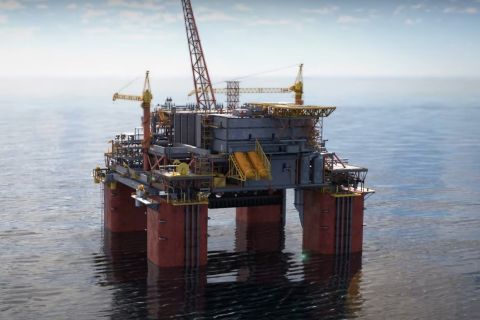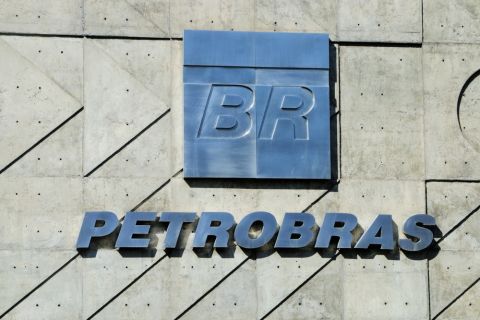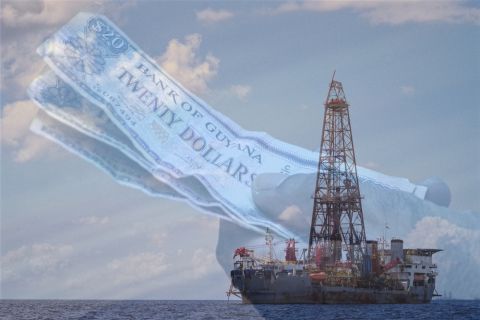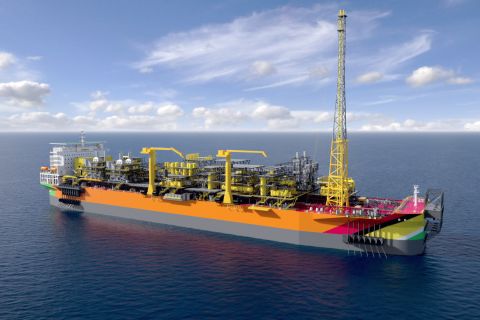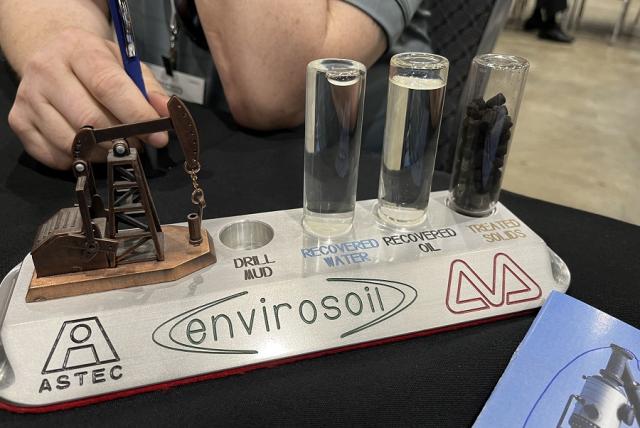
Drilling mud, along with samples of recovered water and oil and pellets generated by the process. (Source: Hart Energy)
A company taking “waste not, want not” to heart has developed a vacuum-assisted oil recovery process that makes it possible to reuse drilling mud.
The technology, which emerged from the construction industry, recovers used drilling fluid and water and generates fuel pellets. Nova Scotia-based R3 Environmental Systems, a subsidiary of Municipal Group of Companies, started developing the process in 2017, and in 2022 the Vacuum Assisted Pure Oil Recovery process received OTC Spotlight on New Technology recognition.
R3’s process heats used drilling fluid under a vacuum to evaporate out the oil and water fractions before condensing them and separating them into hydrocarbon and water products. Circulating the used fluid under heat and 20 mm to 40 mm of mercury lowers the boiling point—speeding up the distillation process and reducing the energy required to boil off the oil, said Patrick Rooney, director of manufacturing for Municipal Group of Companies.
Normally, he said, the recovered fluids would boil off at temperatures as high as 350 C.
“We’re boiling it off at 170 degrees Celsius, so therefore we’re not cracking” or degrading the oil, he said. “We’re pulling off just the virgin oil.”
He said the process makes it possible to use one part of recovered oil to heat the system while leaving two parts of recovered oil available for resale or further reuse.
“We're actually burning the oil in our industrial heaters,” Rooney said.
The recovered distilled water contains no chlorides, he added.
“The water could go back for a new formulation because being distilled water, there's no more chlorides in it. They could actually use that again to reformulate drill mud or use it in the process somewhere else. And in lots of places where water is scarce, it's very valuable to get the water back,” he said.
'200 mistakes ahead'
Jerry Scott, general manager for R3 said the amount of water in the mud affects the speed of the process.
“It takes a lot of energy to burn off the water. So if there's a lot of water,” the process takes longer, he said.
On average, the system can treat about two tons of used drilling fluid per hour.
Scott said the company started looking for a way to extract oil from drilling mud without cracking some years back. There are, he said, other technologies that can extract the oil, but rather than returning virgin quality oil, it’s degraded.
Rooney said the company investigated a number of technologies before choosing a path to pursue.
“Dyson never invented the cyclone. He's just the first one to put it in a vacuum,” Rooney said. “We looked at these different technologies and one of the ones that fascinated us was distillation.”
But pumping sludges under a vacuum posed some problems.
“Sludges are hard to pump in the first place. They’re abrasive,” he said.
Scott said pump vendors were not receptive to the concept.
“We had a lot of pump vendors even refusing to quote us once we told them the operating conditions,” he said.
Through a series of test projects, R3 was able to test different types of pumps and refine the system to include a combination of peristaltic pumps with high heat hoses and lobe pumps.
“We're better than the competition right now because we're 200 mistakes ahead of them,” Rooney said.
The process has been used offshore Newfoundland and Labrador for a year.

“We have good recovery rates for the oil in the water,” Rooney said. “That’s gone very well with multiple different types of mud.”
And while the process returns virgin oil and reusable water, it also creates fuel pellets, which can be used in cement kilns or industrial furnaces.
“Ideally, we'd like to make a fuel pellet that someone can use,” Scott said.
However, Rooney said, not all regions or operations are set up to use the resulting pellets.
He said the company is now working to make the process “highly mobile” to allow it to be used in remote locations where supply of drilling fluids is more difficult and recovered oil would be useful.
“The oil could be reused over and over and over again. So as long as it comes back to us as waste, we could reproduce the same base oil that could be over and over because we're not degrading it,” he said.
The whole process, Scott said, reduces the carbon footprint of operations.
“Typically to drill one well, we can save them about 400 tons of CO2 emissions,” he said. “It’s a start.”
Recommended Reading
Deepwater Roundup 2024: Offshore Australasia, Surrounding Areas
2024-04-09 - Projects in Australia and Asia are progressing in part two of Hart Energy's 2024 Deepwater Roundup. Deepwater projects in Vietnam and Australia look to yield high reserves, while a project offshore Malaysia looks to will be developed by an solar panel powered FPSO.
Petrobras to Step Up Exploration with $7.5B in Capex, CEO Says
2024-03-26 - Petrobras CEO Jean Paul Prates said the company is considering exploration opportunities from the Equatorial margin of South America to West Africa.
Exxon Versus Chevron: The Fight for Hess’ 30% Guyana Interest
2024-03-04 - Chevron's plan to buy Hess Corp. and assume a 30% foothold in Guyana has been complicated by Exxon Mobil and CNOOC's claims that they have the right of first refusal for the interest.
Pitts: Heavyweight Battle Brewing Between US Supermajors in South America
2024-04-09 - Exxon Mobil took the first swing in defense of its right of first refusal for Hess' interest in Guyana's Stabroek Block, but Chevron isn't backing down.
Exxon Ups Mammoth Offshore Guyana Production by Another 100,000 bbl/d
2024-04-15 - Exxon Mobil, which took a final investment decision on its Whiptail development on April 12, now estimates its six offshore Guyana projects will average gross production of 1.3 MMbbl/d by 2027.


